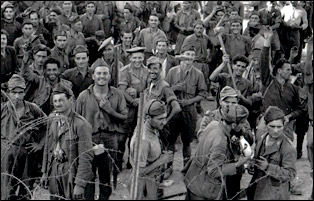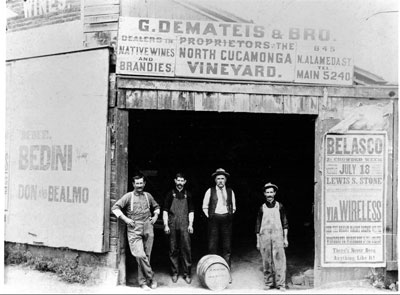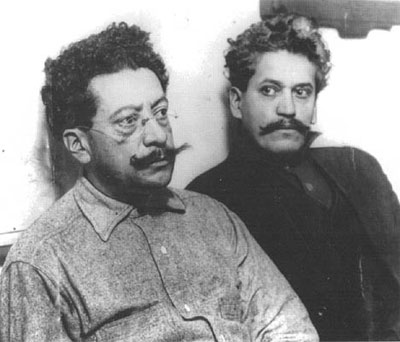The gorgeous Silvana Mangano singing her famous mambo from the 50’s movie “Anna†(banned in some places for years), Mangano, in this movie I saw as a kid at the old Starland Theatre in Lincoln Hts, even though it was on the list of forbidden movies tacked onto the front doors of Sacred Heart Church, was my first pubescent sexual fantasy and she still turns me on.
The LA Eastside has always been a melting pot and home to immigrants from many places in the world. Boyle Hts and East Los Angeles, besides Mexicans, had the Jewish, Russian, Japanese and Armenian immigrant communities, Lincoln Heights and environs had the Irish, Italians, Okies (immigrants?), and Mexicans, among others. This stew sometimes produced the typical ethnic clashes, stereotyping and prejudice, but more often, on the much more common positive side, gave one the opportunity (especially the children growing up together), to learn about and understand other cultures. This education was priceless to me and Lincoln Hts was one of those special places where different working class ethnic groups all lived in close proximity and where many lifelong friendships were established, on the streets, in school, at work, and through intermarriage.
The glue or common bond that brought and held together the Mexican American, Italian, and Irish families in Lincoln Hts was the Catholic Church, it seemed everything revolved around it. Sacred Heart, Our Lady Help of Christians, Saint Peter’s, the schools, the weddings, the baptisms, the funerals.
When I attended Sacred Heart School in the 1950’s it was about half Italian and half Mexican American with a few Irish kids thrown in.
At that time there were still children of Italian immigrants, offspring of Italian POW’s and Italian women from Lincoln Hts. going to school with me.
During WW2 there was an Italian POW camp in San Bernardino and many LA families would visit the Italian POW’s on Sundays and have picnics and get togethers where many of these POW’s met their future wives and never went back to Italy after the war was over.
POWs could be escorted out of the camp.
history – Prisoners in Paradise
The priests at Sacred Heart School and Church were 100% Irish from the old sod and openly despised the Mexicans and Italians as fornicators and thieves, quaint and simple, yet obedient. Saint Patrick’s Day was a school holiday, on St Josephs Day (Italian), we were given off the afternoon so that we could attend the many St Joseph Feasts given in his honor by Lincoln Hts Italian families. Dia de la Virgen de Guadalupe was recognized with a holy mass, but normal school hours were in effect, those Irish Priest couldn’t fathom the Holy Mother of God as a brown Indian!
The Italian immigration to California is said to consist of mainly northern Italians but in Lincoln Hts the families I knew were almost all from Sicily or Southern Italy. And I discovered that unlike most Italian immigrants who came through Ellis Island in New York, the Italian families in Lincoln Hts came through New Orleans and Mobile Alabama.
The Sicilians and southern Italians are a darker skinned group than their Northern Italian countrymen and many times there would be confusion about the ethnicity of a person. Are you Mexican or Italian? Dago or Chicano? This was a common question growing up in Lincoln Hts.
The very common intermarriage between these groups created even more confusion sometimes. The Bonfiglio’s and Fiore’s were both Mexican and Italian but seemed more Chicano while my friend Manuel Flores from Happy Valley would always be good for a gallon or so of “Dago Red†that his grandpa, Mr. Matranga, would produce.
A very common sight on No. Broadway at certain times of the year would be the old Italian men, pulling a communal wine press on wheels behind their old pickups. The Italians always had not only fruit trees and gardens in their yards but also wine grapes growing all over their fences to make their wine with.
There is even a distinct Lincoln Hts accent or voice inflection that evolved with this interchange of cultures, many of the Italians that grew up there have a kind of Chicano accent and vice versa. I can recall as a 10 or 11 year old, running the streets with my friends Dodi Lujan, Vito Feri, Joe Bruno, and Freddie Jasso. We would scam the Old Italian immigrant who owned the little corner store across from Gates St. School, where kids would buy wax candy lips, jawbreakers, ice cream, and junk candy and soda pop.
A couple of us would run in the front door and yell out “vaffanculo scabuchi†(sic); which meant something like “go fuck yourself cabbage headâ€, the crabby old man would chase a couple of us down the street while the others would stuff candy and sodas into our shirts and run off with the loot.
The Italian/Mexican connection in LA goes way back, the “Pelanconi Bldg.†is the oldest brick bldg in Los Angeles and now the site of La Golondrina Restraunt on Olvera St., it’s also the site of the famous Mexican muralist David Alfaro Siqueiros’ mural “America Tropicalâ€, painted while here in exile.
The Mexican anarchist Ricardo Flores Magon and his brother gave a speech at the Italian Hall during the time free speech was illegal in Los Angeles, it drew over a thousand people and was broken up by the infamous LAPD “red squadâ€, Emma Goldman also spoke there as in those days the Italians were working people and sided with the working class’s, the famous Italian anarchists “Sacco and Vanzetti†were a famous example.
The Italian Hall
The Italian Hall was a popular site for weddings, banquets, … weekend foot races that commenced at the Italian Hall and concluded in nearby Lincoln Heights. … to as Una Storia Segreta, which in Italians means, “the secret history. …
www.italianhall.org/history.php
Definition of who was a true American.
A great history of Italian/Mexican American interchange exists on the LA Eastside, that is again, unique and colorful.
By the way this clip from the movie “Caro Diario†with the great Italian actor Nanni Moretti getting down with Silvana Mangano reminds me of a Lincoln Hts childhood friend “Sapo†Fiore dancing to that tune, thinking of Silvana Mangano.




Yet another great narrative told by the aptly self-named Don Quixote. Thanks again for this snippet of history. As a long-time resident of Lincoln Hts I really do enjoy reading this oft forgotten history.
Many think of the Eastside as a purely Latino enclave of Los Angeles and this couldn’t be further from the truth. And the mentions of los Magón and Ms. Goldman speaking at the Italian Hall is something I never ever knew about !
Thank you so much for this. I’m loving it.
[Also, why was that song banned? Of course by today’s standard it’s rather innocuous but it must have some hidden meaning to have warranted its banning.]
I think that the Okies definitely count as immigrants to this region. My grandfather’s family on my mother’s side would easily be considered of that set (even though they came from a failed ranch in New Mexico). They were as new to this part of the U.S. as anybody else that came here en masse in that era. Funny, though, how they became “white” soon after!
great article dq. I learned a lot.
I love this post! I wasn’t really familiar with Lincoln Heights’ Italian community until I read Famous All Over Town and started asking my family questions.
I remember meeting one of the remaining Italian families on Eastlake a few years ago when I was thinking of renting the neighboring house, so some of the families are still here.
My aunt and her best friend grew up in Lincoln Heights in the 50s and 60s. Her best friend is half Italian and half Mexican and yes, they both went to Sacred Heart. 🙂
Beautiful post.
I didn’t know, but am not so surprised to hear of the Italians in Lincoln Heights. Nor am I surprised to hear that anarchists were invited to speak at te Italian Hall. A little known part of American radical history is the extent of Italian radicals who spent time here. It is not so well known, because they published their papers in Italian. An archive of publications by radical immigrants in a university in either Wisconsin (if I am remembering right) has hundreds of Italian language anarchist and socialist publications published in the US…
I also find the descriptions of relationships among the various groups interesting. I grew up in the Chicago area. During the 1940s, I believe, there was an influx of Appalachian “hillbillies” into Chicago. Due to poverty they ended up living in neighborhoods with the other poor folks of Chicago–mostly black and Puerto Rican–and there were tensions, but in the late 1960s, young people from all groups (organized in street gangs) got together in anti-war, anti-cop and related activities mostly centered on the realities of their daily lives.It is one of those things that I have found bits and pieces about, but would like to look into more deeply.
Thanks all, for the nice comments, it’s appreciated.
Julio it wasn’t the popular song of the time that Silvana Mangano sang that was banned, it was the movie “Anna” that was on the Catholic Church’s shitlist, The Legion of Decency to be exact, which was a very powerful edict of the time. Your question got me to thinking about the Church’s banned movies and I’m going to post something up here at LA Eastside that deals with it.
Ubrayj02,
The Okies didn’t necessarily only come from Oklahoma, if you travel through the prarie’s of Eastern New Mexico and Colorado, West Texas, Western Kansas you will still see the remants of the dust bowl towns that spawned the migration to the California promised land.
Some ended up in Lincoln Hts and I had many friends that grew up with us Chicanos who were the offspring of the Okies. Some of those people were as racist and ignorant as you can imagine and some were as sweet and welcoming as your closest relative, I guess all ethnicities share this in common. I have lifelong friends I grew up with that mostly intermarried into Chicano families, a very common occurence in those days, and most of the boys were as tough as you’ll find, they had to be to survive growing up a minority within a minority in those old tough Lincoln Hts neighborhoods.
Chimatli, the more you write about your family the more I would bet I know some of them, they sound real familiar to me.
Apio, it was an interesting mix that occured then and remember that Lincoln Hts was a very working class, union oriented area in a very right wing anti democratic era of Los Angeles history. It made for some very explosive and radical actions by working people.
Growing up in Lincoln Heights since 1968, I have been aware of our diversity here. I definitely saw the Italians; Joe and Al, the ice cream truck men,the various Italian-American residents along Eastlake,Minnesota and other streets along my Lincoln Heights Bulletin route, and of course,the Lanza Bros.on Main and I think the San Antonio Winery people are Italian. My mom is Nicaraguan and she had some family also live in the Heights. There is still to this day Puerto Ricans living on George ST. A lot of my buddies from the Gates days had definite Native American roots(the Gonzaleses,Vaizes,Maruffos) and the First Native American church is on Hancock. Of course our proximity to Chinatown gave us many a Chinese-American neighbor and friends. The 1979 boat lift from Vietnam downloaded many a Refugee on Lincoln Heights’doorstep(see Avenue 26)African-American families would hold reunions at Lincoln Park decades ago. I grew up with an El Salvadorean pal in the eighties and there still a smattering of white folk residing in the Heights whether it be up in the hills or down in the Brewery.
beautiful post DQ, gracias.